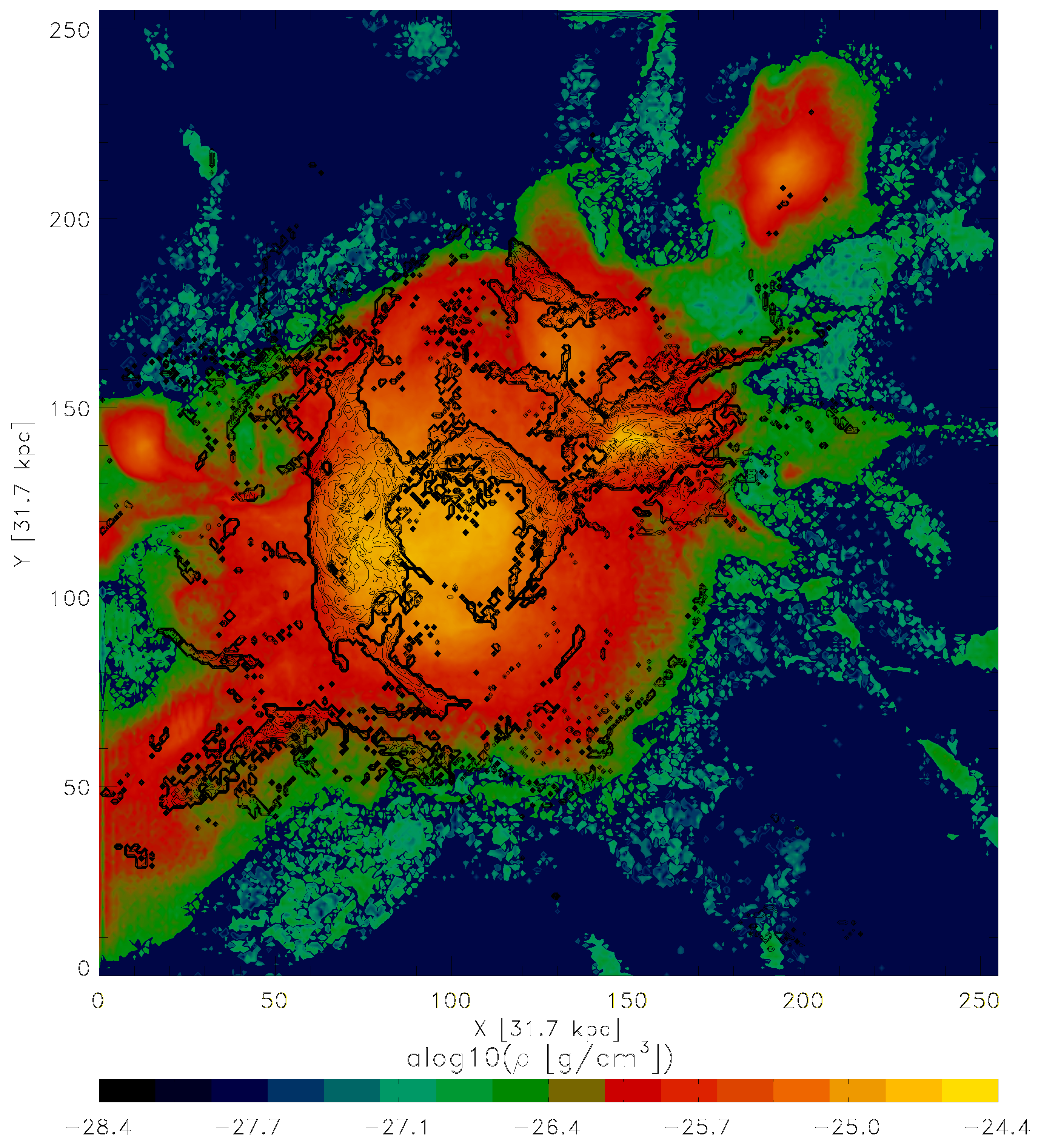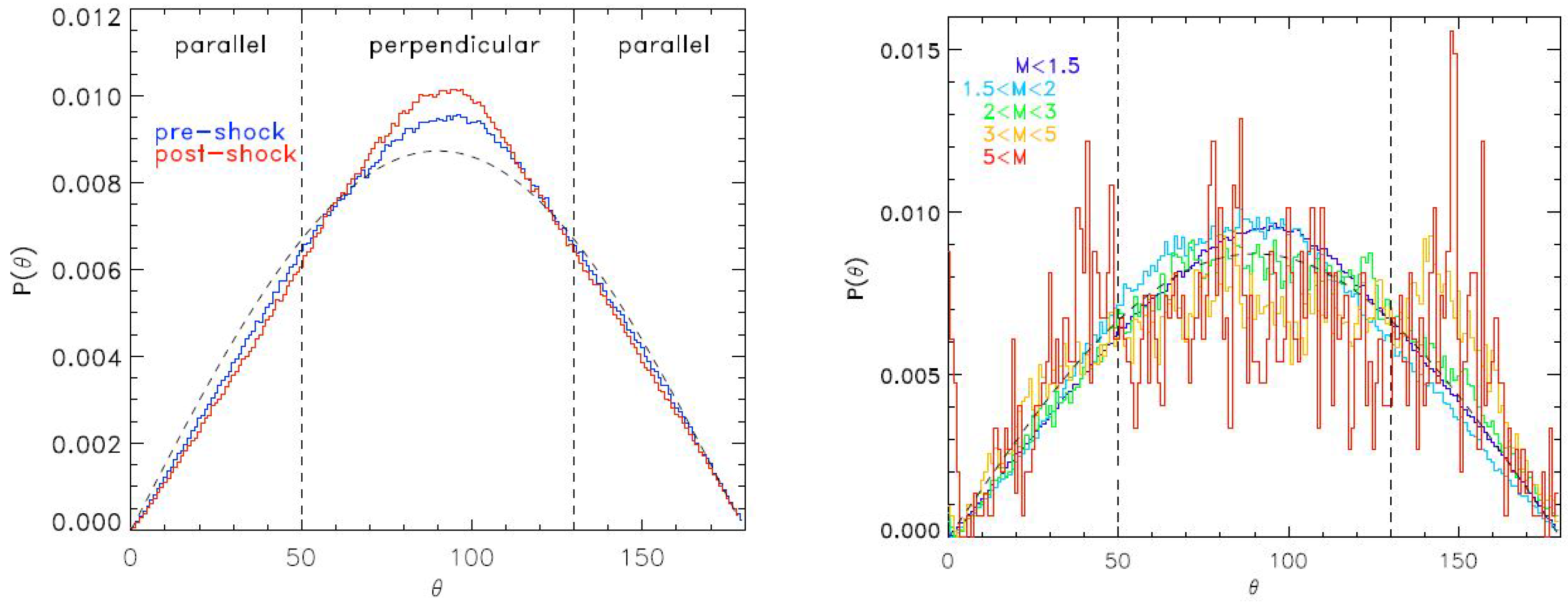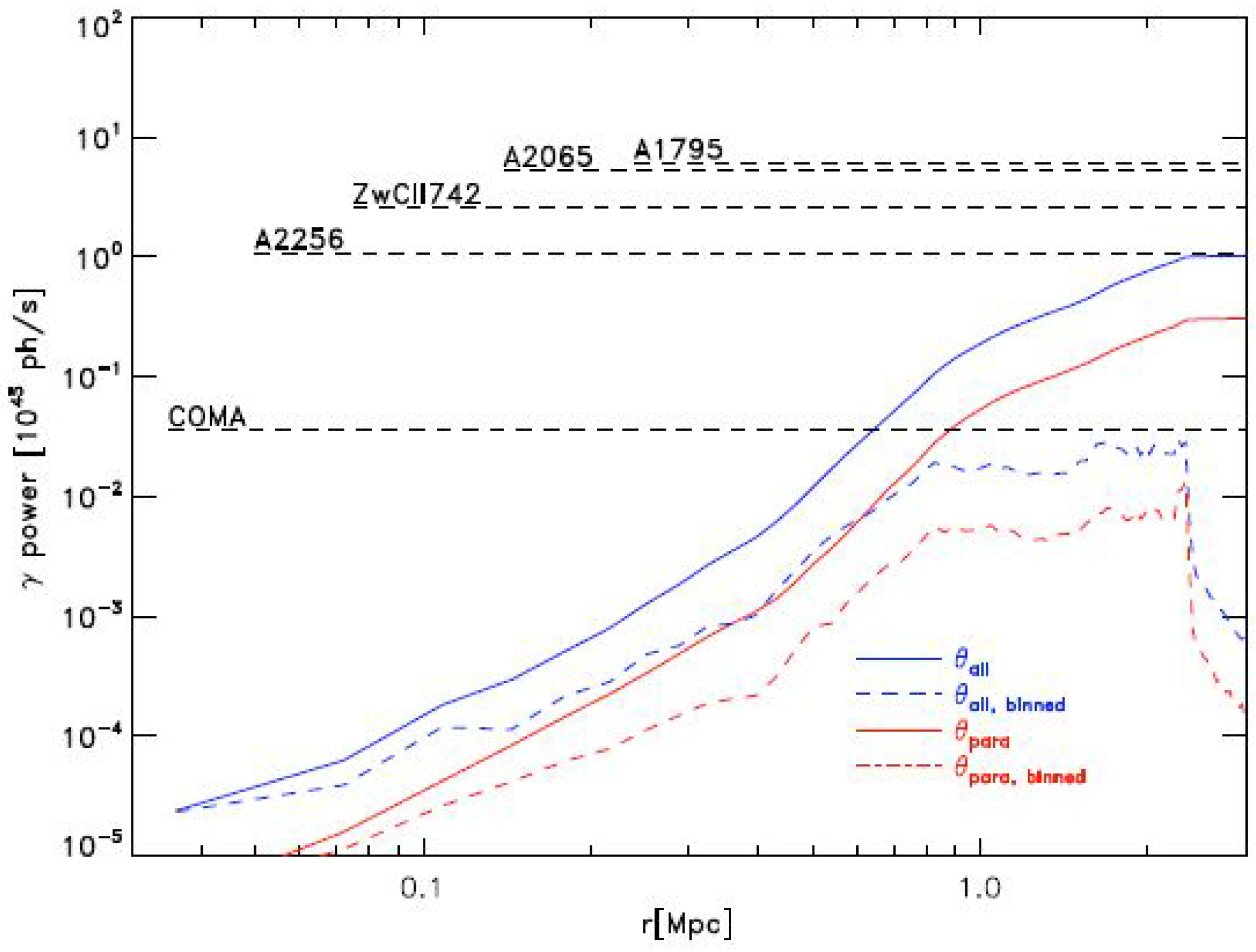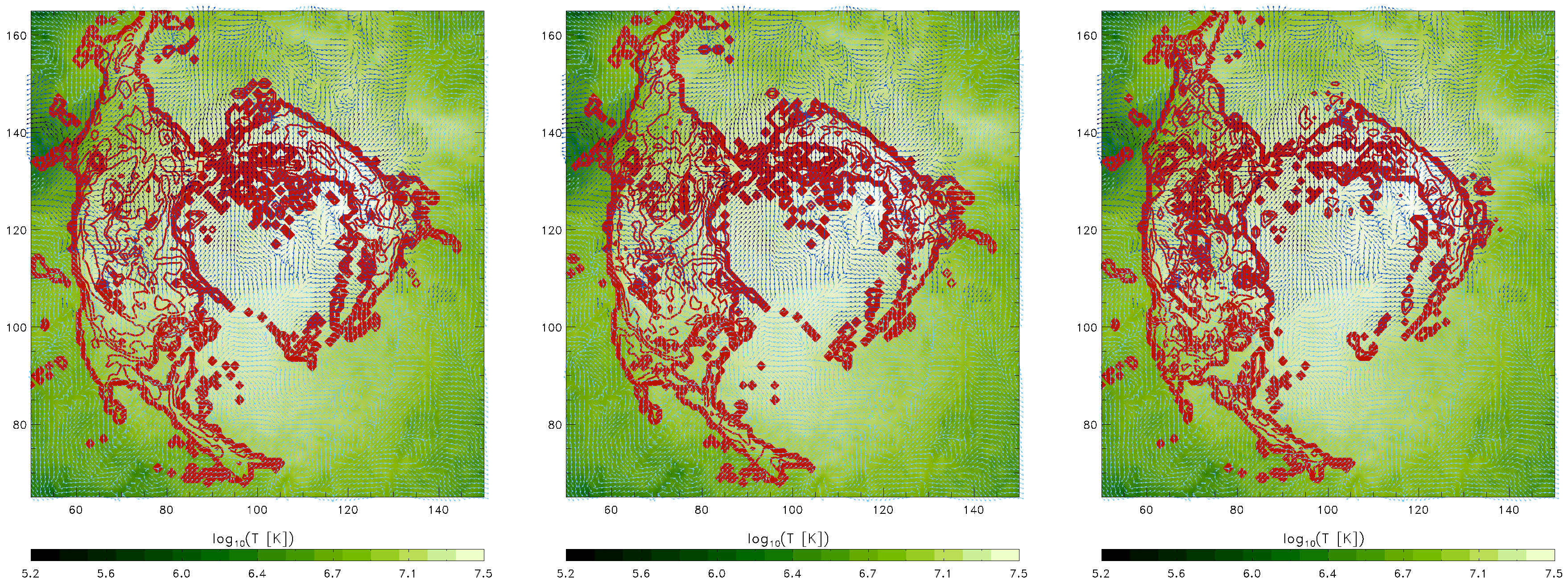Studying the Effect of Shock Obliquity on the γ-ray and Diffuse Radio Emission in Galaxy Clusters
Abstract
:1. Introduction
2. Methods
2.1. Cosmological MHD Simulations
2.2. Lagrangian Analysis
3. Results
3.1. γ-ray Emission
3.2. Radio Emission
4. Discussion
Acknowledgments
Author Contributions
Conflicts of Interest
References
- Brunetti, G.; Jones, T.W. Cosmic Rays in Galaxy Clusters and Their Nonthermal Emission. Int. J. Mod. Phys. D 2014, 23, 30007. [Google Scholar] [CrossRef]
- Atwood, W.B.; Abdo, A.A.; Ackermann, M.; Althouse, W.; Anderson, B.; Axelsson, M.; Baldini, L.; Ballet, J.; Band, D.L.; Barbiellini, G.; et al. The Large Area Telescope on the Fermi Gamma-Ray Space Telescope Mission. Astrophys. J. 2009, 697, 1071–1102. [Google Scholar] [CrossRef]
- Ackermann, M.; Ajello, M.; Albert, A.; Allafort, A.; Atwood, W.B.; Baldini, L.; Ballet, J.; Barbiellini, G.; Bastieri, D.; Bechtol, K.; et al. Search for Cosmic-Ray-induced Gamma-Ray Emission in Galaxy Clusters. Astrophys. J. 2014, 787, 18. [Google Scholar] [CrossRef]
- Ackermann, M.; Ajello, M.; Albert, A.; Atwood, W.B.; Baldini, L.; Ballet, J.; Barbiellini, G.; Bastieri, D.; Bechtol, K.; Bellazzini, R.; et al. Search for Gamma-Ray Emission from the Coma Cluster with Six Years of Fermi-LAT Data. Astrophys. J. 2016, 819, 149. [Google Scholar] [CrossRef]
- Ackermann, M.; Ajello, M.; Albert, A.; Atwood, W.B.; Baldini, L.; Barbiellini, G.; Bastieri, D.; Bechtol, K.; Bellazzini, R.; Bissaldi, E.; et al. Search for Extended Gamma-Ray Emission from the Virgo Galaxy Cluster with FERMI-LAT. Astrophys. J. 2015, 812, 159. [Google Scholar] [CrossRef]
- Caprioli, D.; Spitkovsky, A. Simulations of Ion Acceleration at Non-relativistic Shocks. I. Acceleration Efficiency. Astrophys. J. 2014, 783, 91. [Google Scholar] [CrossRef]
- Guo, X.; Sironi, L.; Narayan, R. Non-thermal Electron Acceleration in Low Mach Number Collisionless Shocks. I. Particle Energy Spectra and Acceleration Mechanism. Astrophys. J. 2014, 794, 153. [Google Scholar] [CrossRef]
- Guo, X.; Sironi, L.; Narayan, R. Non-thermal Electron Acceleration in Low Mach Number Collisionless Shocks. II. Firehose-mediated Fermi Acceleration and its Dependence on Pre-shock Conditions. Astrophys. J. 2014, 797, 47. [Google Scholar] [CrossRef]
- Wittor, D.; Vazza, F.; Brüggen, M. Testing cosmic-ray acceleration with radio relics: A high-resolution study using MHD and tracers. 2016; arXiv:1610.05305. [Google Scholar]
- Bryan, G.L.; Norman, M.L.; O’Shea, B.W.; Abel, T.; Wise, J.H.; Turk, M.J.; Reynolds, D.R.; Collins, D.C.; Wang, P.; Skillman, S.W.; et al. ENZO: An Adaptive Mesh Refinement Code for Astrophysics. Astrophys. J. Suppl. 2014, 211, 19. [Google Scholar] [CrossRef]
- Colella, P.; Glaz, H.M. Efficient solution algorithms for the Riemann problem for real gases. J. Comput. Phys. 1985, 59, 264–289. [Google Scholar] [CrossRef]
- Dedner, A.; Kemm, F.; Kröner, D.; Munz, C.D.; Schnitzer, T.; Wesenberg, M. Hyperbolic Divergence Cleaning for the MHD Equations. J. Comput. Phys. 2002, 175, 645–673. [Google Scholar] [CrossRef]
- Genel, S.; Vogelsberger, M.; Nelson, D.; Sijacki, D.; Springel, V.; Hernquist, L. Following the flow: Tracer particles in astrophysical fluid simulations. Mon. Not. Roy. Astron. Soc. 2013, 435, 1426–1442. [Google Scholar] [CrossRef]
- Ryu, D.; Kang, H.; Hallman, E.; Jones, T.W. Cosmological Shock Waves and Their Role in the Large-Scale Structure of the Universe. Astrophys. J. 2003, 593, 599–610. [Google Scholar] [CrossRef]
- Kang, H.; Ryu, D. Diffusive Shock Acceleration at Cosmological Shock Waves. Astrophys. J. 2013, 764, 95. [Google Scholar] [CrossRef]
- Vazza, F.; Gheller, C.; Brüggen, M. Simulations of cosmic rays in large-scale structures: Numerical and physical effects. Mon. Not. Roy. Astron. Soc. 2014, 439, 2662–2677. [Google Scholar] [CrossRef]
- Hoeft, M.; Brüggen, M. Radio signature of cosmological structure formation shocks. Mon. Not. Roy. Astron. Soc. 2007, 375, 77–91. [Google Scholar] [CrossRef]
- Vazza, F.; Eckert, D.; Brüggen, M.; Huber, B. Electron and proton acceleration efficiency by merger shocks in galaxy clusters. Mon. Not. Roy. Astron. Soc. 2015, 451, 2198–2211. [Google Scholar] [CrossRef]
- Donnert, J.; Dolag, K.; Cassano, R.; Brunetti, G. Radio haloes from simulations and hadronic models - II. The scaling relations of radio haloes. Mon. Not. Roy. Astron. Soc. 2010, 407, 1565–1580. [Google Scholar] [CrossRef]
- Huber, B.; Tchernin, C.; Eckert, D.; Farnier, C.; Manalaysay, A.; Straumann, U.; Walter, R. Probing the cosmic-ray content of galaxy clusters by stacking Fermi-LAT count maps. Astron. Astrophys. 2013, 560, A64. [Google Scholar] [CrossRef]
- Brunetti, G.; Lazarian, A. Particle reacceleration by compressible turbulence in galaxy clusters: Effects of a reduced mean free path. Mon. Not. Roy. Astron. Soc. 2011, 412, 817–824. [Google Scholar] [CrossRef]
- Wiener, J.; Oh, S.P.; Guo, F. Cosmic ray streaming in clusters of galaxies. Mon. Not. Roy. Astron. Soc. 2013, 434, 2209–2228. [Google Scholar] [CrossRef]
- Lazarian, A. Damping of Alfven waves by Turbulence and its Consequences: From Cosmic-Rays Streaming to Launching Winds. 2016; arXiv:1607.02042. [Google Scholar]
- Wright, E.L. A Cosmology Calculator for the World Wide Web. Publ. Astron. Soc. Pac. 2006, 118, 1711–1715. [Google Scholar] [CrossRef]





© 2016 by the authors; licensee MDPI, Basel, Switzerland. This article is an open access article distributed under the terms and conditions of the Creative Commons Attribution (CC-BY) license (http://creativecommons.org/licenses/by/4.0/).
Share and Cite
Wittor, D.; Vazza, F.; Brüggen, M. Studying the Effect of Shock Obliquity on the γ-ray and Diffuse Radio Emission in Galaxy Clusters. Galaxies 2016, 4, 71. https://doi.org/10.3390/galaxies4040071
Wittor D, Vazza F, Brüggen M. Studying the Effect of Shock Obliquity on the γ-ray and Diffuse Radio Emission in Galaxy Clusters. Galaxies. 2016; 4(4):71. https://doi.org/10.3390/galaxies4040071
Chicago/Turabian StyleWittor, Denis, Franco Vazza, and Marcus Brüggen. 2016. "Studying the Effect of Shock Obliquity on the γ-ray and Diffuse Radio Emission in Galaxy Clusters" Galaxies 4, no. 4: 71. https://doi.org/10.3390/galaxies4040071




